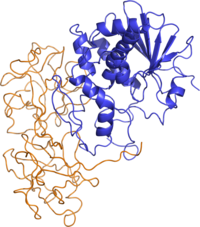
Photo from wikipedia
Abstract Background Children less than 1 year of age are commonly colonized with toxin-producing C. difficile, but appear to be immune to the associated colitis. Animal studies suggest that young… Click to show full abstract
Abstract Background Children less than 1 year of age are commonly colonized with toxin-producing C. difficile, but appear to be immune to the associated colitis. Animal studies suggest that young infants lack receptors for C. difficile toxin, though this has never been documented in humans. Methods Tissue from infants (<6 months) and adults > 21 years were studied. Toxin A binding was assessed using an indirect staining method, which included incubation with toxin A (List Labs) and detection with a rabbit polyclonal anti-sera (Lee Labs). A trained pediatric pathologist assessed the extent of staining in a blinded fashion. In other studies, toxin A was labeled with rhenium-188 and incubated with albumin-blocked tissue sections (four-infant and six-adult) for 1 hour. After washing, gamma counts were measured and the average percentage of retained radiolabeled toxin A calculated. Fisher exact tests and ANOVA were used for analyses. All studies were done in compliance with our institutional IRB. Results Six of 13 (46%) adult specimens were found to have reactivity on both the apical epithelial surface as well as crypt staining. Another six had reactivity localized only to the basal and lateral surface of the crypts. One specimen demonstrated no reactivity at all. For neonates (n = 15), no specimens were found to have reactivity localized to the apical epithelial surface, though four specimens had reactivity at the basal epithelial surface (P value for comparison of apical staining 0.0046) (see figure). Average percentage of retained counts for control (no tissue), infant and adult colon sections were, 0.318 ± 0.147, 0.305 ± 0.079 and 0.48 ± 0.114, respectively (P = 0.051). Conclusion Immunohistochemistry and radiolabelling studies indicate that neonatal colon section binds C. difficile toxin A less strongly and in a different distribution pattern (i.e., without apical staining) when compared with adult colon sections. These findings are consistent with previous animal studies and support the paradigm that a lack of toxin receptors in the infant colon contributes to immunity against C. difficile colitis. Additional studies are needed to define the presence of specific receptors and determine if a similar phenomenon applies to toxin B binding. Disclosures All authors: No reported disclosures.
Journal Title: Open Forum Infectious Diseases
Year Published: 2018
Link to full text (if available)
Share on Social Media: Sign Up to like & get
recommendations!